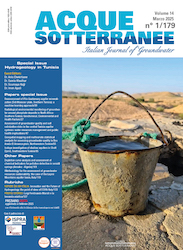Methodology for the assessment of groundwater resources sustainability: the case of the Lepini mountains aquifer basin, Italy
Published: 31 March 2025
Abstract Views: 278
PDF: 111
Publisher's note
All claims expressed in this article are solely those of the authors and do not necessarily represent those of their affiliated organizations, or those of the publisher, the editors and the reviewers. Any product that may be evaluated in this article or claim that may be made by its manufacturer is not guaranteed or endorsed by the publisher.
All claims expressed in this article are solely those of the authors and do not necessarily represent those of their affiliated organizations, or those of the publisher, the editors and the reviewers. Any product that may be evaluated in this article or claim that may be made by its manufacturer is not guaranteed or endorsed by the publisher.
Similar Articles
- Bernardo Mazzanti, Isabella Bonamini, Gaia Checcucci, Lucia Fiumi, Francesco Consumi, Stefano Bartalesi, Giovanni Montini, The UN System for Environmental-Economic Accounts for Water (SEEA-W) and groundwater management: the experience of the Arno River Basin Authority within the PAWA project , Acque Sotterranee - Italian Journal of Groundwater: Vol. 3 No. 3 (2014)
- Vincenzo Marsala, LIFE+ TRUST project: tool to assist the implementation of the Framework Directive 2000/60/CE, methodology and results , Acque Sotterranee - Italian Journal of Groundwater: Vol. 3 No. 3 (2014)
- Irena Kopa?, Matevž Vremec, Slovenian test case Vrbanski Plato aquifer in the EU HORIZON 2020 FREEWAT project , Acque Sotterranee - Italian Journal of Groundwater: Vol. 6 No. 3 (2017)
- Giovanni Pranzini, Francesco Di Martino, Ester Della Santa, Katia Fontanelli, Gianni Fucci, Impact of climate change on the water balance of the Apuo-Versilia plain acquifer (Tuscany, Italy) , Acque Sotterranee - Italian Journal of Groundwater: Vol. 9 No. 3 (2020)
- Cherifa Hanene Kamelia Chemirik, Djelloul Baahmed, Rachid Nedjai, Djamel Boudjemline, Ikram Mahcer, The use of geographic information systems and remote sensing to evaluate climate change effect on groundwater: application to Mostaganem Plateau, Northwest Algeria , Acque Sotterranee - Italian Journal of Groundwater: Vol. 13 No. 4 (2024)
- Giovanni Braca, Martina Bussettini, Rossella Maria Gafà, Gennaro Maria Monti, Lucio Martarelli, Angelantonio Silvi, Francesco La Vigna, The Nationwide Water Budget Estimation in the light of the New Permeability Map of Italy , Acque Sotterranee - Italian Journal of Groundwater: Vol. 11 No. 3 (2022)
- Halake Guyo Rendilicha, A review of groundwater vulnerability assessment in Kenya , Acque Sotterranee - Italian Journal of Groundwater: Vol. 7 No. 2 (2018)
- Bernardo Mazzanti, Isabella Bonamini, Gaia Checcucci, Climate changes and water resource planning: WIZ, an operational tool , Acque Sotterranee - Italian Journal of Groundwater: Vol. 2 No. 3 (2013)
- Partha Sarathi Datta, Ensemble models on palaeoclimate to predict India's groundwater challenge , Acque Sotterranee - Italian Journal of Groundwater: Vol. 2 No. 3 (2013)
- Paolo Severi, Luciana Bonzi, Venusia Ferrari, Immacolata Pellegrino, Managed aquifer recharge in the Marecchia alluvial fan (Rimini - Italy), start of the test and first results , Acque Sotterranee - Italian Journal of Groundwater: Vol. 3 No. 3 (2014)
1-10 of 343
Next
You may also start an advanced similarity search for this article.









